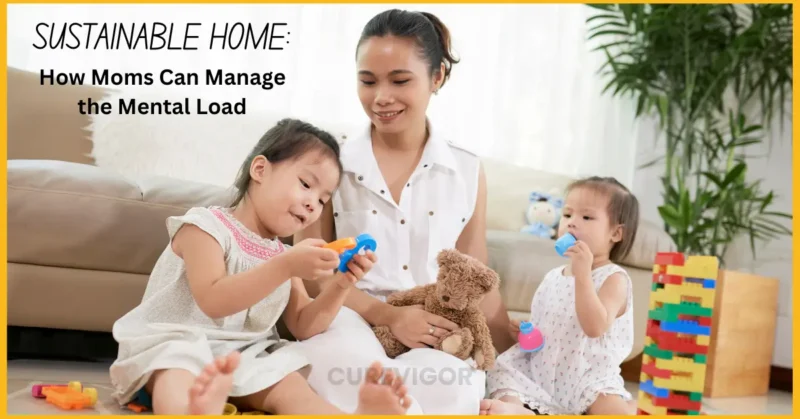Create a peaceful, sustainable home. Learn to deconstruct the Mental Load with actionable systems, delegation, and boundary-setting strategies. Stop burnout.
Thank you for reading this post, don't forget to subscribe!A healthy home is more than just a clean house or a perfectly balanced meal; it is a sanctuary of peace powered by the sustainable energy of the people who run it. And for many families, that energy source is the mother.
How Moms Can Manage the Mental Load to Create a Peaceful, Sustainable home
You know the job description: you are the CEO, logistics manager, emotional support, chief event planner, and nutritionist—all rolled into one. This relentless, invisible labor is known as the Mental Load, and it’s the most significant invisible drain on a mother’s well-being.
The Mental Load is the constant state of knowing and remembering everything the family needs, such as whether the dog is due for a vet visit. Did I RSVP to the birthday party?
Does the baby need new shoes? Are we low on milk? What is everyone eating tonight?

When this mental effort becomes overwhelming, it leads to burnout, stress, and a less joyful home environment. This comprehensive guide moves beyond basic tips to offer actionable systems for deconstructing the mental load, sustaining your energy, and building a genuinely peaceful, healthy home that runs itself—not because you constantly push it.
The Unseen Labor: Defining and Quantifying the Mental Load
Before you can offload the mental load, you must first acknowledge its true size. It is the invisible checklist that never ends, and it is the key difference between doing a task and managing a task.
The Invisible Checklist: A Daily Inventory
The average woman handles significantly more planning and monitoring tasks than her partner, regardless of whether she works outside the home. These aren’t physical chores; they are the proactive steps required to ensure the household functions.
Here is a partial inventory of the silent tasks draining your energy every single day:
- Logistical Planning: Scheduling, coordinating, and managing all family appointments (doctors, dentists, school meetings, camps).
- The Consumption Cycle: Anticipating needs, planning meals, writing shopping lists, and monitoring pantry/supply levels.
- Emotional Labor: Remembering milestones, managing sibling dynamics, mediating conflicts, and tracking the emotional states of every family member.
- Administrative Oversight: Paying bills, managing insurance, filing paperwork, and handling school communication.
- Proactive Maintenance: Remembering when things expire, when appliances need service, or when clothing sizes need upgrading.
Understanding this inventory is the first step toward delegating the responsibility, not just the execution. You aren’t asking for help folding laundry (execution); you’re asking for help managing the laundry cycle (responsibility: monitoring detergent, scheduling wash days, organizing drawers).
Why the Mental Load Leads to Burnout
When the brain is constantly running this checklist in the background, it never gets a true rest. This chronic low-grade stress manifests physically and emotionally:
- Decision Fatigue: Every minor choice (What’s for dinner?) feels massive, leading to irritability and poor coping mechanisms.
- Loss of Presence: You can’t be fully present with your children or partner because your mind is always running future scenarios (Did I remember to order the birthday cake?).
- Physical Exhaustion: Constant cognitive effort leads to physical and emotional burnout, making it harder to maintain your own healthy eating habits or exercise routines.
The solution is not to try harder, but to build systems that externalize the load from your brain and distribute it across the family.
Deconstructing the Load: Systems for Sustainable Delegation
You need to shift from being the Gatekeeper of Knowledge (the single point of failure) to the Architect of Systems. The goal is to make the information and the responsibilities accessible to everyone.
1. The Centralized Command Center (Externalizing the Brain)
Move the core logistical knowledge out of your head and onto a shared, visible platform.
- The Shared Digital Calendar: Use a single, color-coded digital calendar (Google Calendar, Outlook) accessible to all adults. Every appointment, play date, school event, and project deadline goes here immediately. The rule: If it’s not on the calendar, it doesn’t exist.
- The Master List Hub: Use a simple, shared note app (Trello, Notion, shared phone notes) for recurring tasks and long-term planning. Create separate lists for:
- The Master Grocery List (Live)
- Upcoming Birthday Gifts
- Routine Home Maintenance (filter check, window cleaning)
- The Responsibility Handoff: Clearly assign ownership of entire areas. For example, your partner owns “Car Maintenance” (remembering oil changes, registration, cleaning), or a teenager owns “Pet Care” (food stock, vet reminders, walks). Ownership means they are responsible for the planning and execution of the task.
2. Systemizing Communication: The Daily Huddle
Stop the constant stream of questions (“Where are my shoes?” “What time is practice?”) by creating a predictable communication structure.
- The Daily Five-Minute Huddle: At the same time every day (e.g., after dinner or before bed), hold a quick meeting with your partner to review the next 24 hours. This eliminates the need for you to interrupt your flow with updates constantly.
- Agenda: Who is handling drop-off/pick-up? What is the dinner plan? Are there any major conflicts or known issues?
- The Information Board: Designate one physical spot—a whiteboard or corkboard—in a high-traffic area (the kitchen). This is the only place to look for urgent information. Post school notices, weekly menus, and quick reminders here. This trains the family to check the system, not the mom.
3. Automate and Outsource Whenever Possible
Look critically at every non-essential task and ask, “Can this be eliminated, simplified, or done by someone else?”
| Task Type | Simplify Action | Mental Load Reduction |
| Cleaning | Switch from deep cleaning to “Minimum Viable Clean.” Focus only on essential hygiene areas (kitchen, bathroom) and delegate surface tidiness. | Reduces the daily pressure to achieve perfection. |
| Grocery Shopping | Use a Subscription Service for non-perishables (diapers, paper towels) and Online Order Pickup for groceries. | Eliminates time spent physically shopping and reduces decision fatigue in the store. |
| Laundry | Adopt the “Personal Responsibility Model.” Assign each family member one day a week to wash, dry, and put away their own clothes. | Offloads the entire management cycle of one of the most draining chores. |
| Decision Making | Use the “First Good Option” rule. When choosing a brand, an outfit, or a simple recipe, stop searching after the first option that meets the criteria. | Limits research and analysis paralysis. |
Sustaining Your Energy: Habits for the Healthy Mom
The cornerstone of a healthy home is the well-being of the mother. You cannot pour from an empty cup. These habits are about setting boundaries and proactively refilling your emotional and physical reserves.
4. The 15-Minute Reset Ritual
You don’t need a three-hour spa day; you need reliable, 15-minute interventions that break the stress cycle before it escalates.
- The Post-Work Buffer: When you transition from work (paid or unpaid) to family time, take 15 minutes alone. Sit in your car, listen to a podcast, or meditate. This ritual clears the mental whiteboard and prevents the stress from one domain from spilling into the next.
- The Screen-Free Start/End: Dedicate the first 15 minutes of your morning and the last 15 minutes of your evening to being completely screen-free. Use this time for simple stretching, deep breathing, or journaling. This reclaims your focus from digital demands.
- The Sensory Switch: When stress spikes, use a strong sensory input to interrupt the anxious thought pattern: stand outside in the sunlight for 15 minutes, rub an essential oil on your temples, or splash cold water on your face.
5. Fueling Your Body: Prioritizing Your Nutrition
Your physical energy is the fuel for your mental capacity. When you skip meals or rely on sugary, refined foods, your stress tolerance drops dramatically.
Instead of trying to find the time to research nutrition, use the systems you’ve built. Remember, this is an area where your site offers premium support, so leverage it:
- Prioritize Protein at Breakfast: This is the most crucial step for sustained energy and blood sugar stability. A protein-rich start prevents the cravings that derail your focus midday.
- Make Your Plate Method a Habit: Use the “half-plate rule” (half vegetables, quarter protein, quarter whole grains) for a quick, balanced meal.
- Use Your Resources: For detailed, scientific support on optimizing your physical health, be sure to reference our sister guides:
- For Your Plate: Check out our complete guide: 30 Science-Backed Healthy Eating Habits to Elevate Your Diet and Energy.
- For Kids’ Meals: Conquer the dinner table with our strategies: Picky Eater Solutions: Healthy Eating Habits for Kids.
6. The Power of “No” and Boundary Setting
A considerable part of the mental load is saying yes to things that stretch you thin. Learning to set boundaries protects your energy and your time.
- Boundary 1: The “No Thanks” Rule: You do not need to give a detailed explanation when declining an invitation, volunteer request, or social commitment. A simple, polite “Thank you for the offer, but I’m unable to take that on right now” is enough.
- Boundary 2: Delegating the Social Calendar: The primary mother often feels responsible for all social planning. Delegate the management of one entire category (e.g., all holiday planning, all sports logistics) to another adult.
- Boundary 3: Protecting Personal Time: Define pockets of time that are non-negotiable (e.g., 8:00 PM to 9:00 PM is reading time, or Saturday morning is solo time). Communicate this boundary clearly to your family, and model the respect for the boundary by enforcing it.
Creating a Peaceful Environment: Systems over Effort

A peaceful home environment isn’t achieved through constant scrubbing; it’s maintained through predictability, communication, and emotional safety.
7. Routines as Automation
Routines are simply tasks that have become so predictable that they require little mental effort to execute. They automate the busywork of the day.
| The Challenge | The Routine (Automation) | Mental Load Reduction |
| Morning Chaos | The “Go Bag” Rule: Every night, have backpacks, lunch boxes, and work bags packed and staged by the door. | Eliminates morning decision-making and searching. |
| Tidying Up | The “Five-Minute Sweep”: Every family member spends five minutes before dinner picking up all communal areas. | Prevents small messes from growing into overwhelming disasters. |
| Emotional Connection | The “Daily Check-In”: Before bed, ask each child/partner: What was your best thing today, and what was your hardest thing? | Ensures open communication happens predictably, not just during a crisis. |
8. Green Cleaning for a Calmer Space
Switching to eco-friendly practices supports a healthy home, not just physically, but mentally. The harsh smells and synthetic chemicals of traditional cleaners can be contributors to low-level stress and poor indoor air quality.
- The Natural Cleaner Trinity: Use simple, effective, and non-toxic cleaners: White Vinegar (disinfecting/glass), Baking Soda (scrubbing/deodorizing), and Lemon Juice (scent/degreasing).
- Ventilation is Key: Ensure proper airflow while cleaning. Opening a window for 10 minutes a day, even in winter, significantly improves air quality, which directly impacts focus and mood.
- Quality over Quantity: Focus on maintaining clean air and surfaces rather than achieving spotless perfection. A simplified routine requires less mental capacity than chasing commercial cleaning standards.
9. Fostering Emotional Safety and Resilience
A healthy home is one where emotions are safe, and conflict is a process, not a crisis. Your role is to model resilience and understanding.
- Active Listening: When a child or partner shares a concern, pause and repeat back what you heard before offering a solution. “It sounds like you’re frustrated because your friend took your toy without asking. Is that right?” This validates their emotion and makes them feel heard.
- Model Conflict Resolution: When disagreements arise between adults, handle them respectfully and privately. Show your children that two people can disagree yet still love and respect each other. Use “I” statements to express feelings without assigning blame.
- Create a Relaxation Space: Designate a cozy corner, a specific chair, or even just a set of noise-canceling headphones as the Family Chill Zone. This is a designated, non-punitive place where anyone can go to self-regulate when feeling overwhelmed.
Conclusion
A healthy, peaceful home is not the result of a mother working herself to exhaustion. It is the result of a mother wisely managing the mental load, setting strong boundaries, and building resilient systems.
By externalizing the daily operational labor, automating routines, and prioritizing your own well-being through essential habits and reset rituals, you shift from being the home’s single point of failure to its calm, consistent center.
Start small today: pick one thing from your invisible checklist and build a system for it, then delegate the execution. Your energy, your health, and your family’s peace will be your reward.
FAQs: Building Support and Resilience
Q. How do I start delegating the mental load without arguing with my partner?
Delegation works best when it’s framed as full responsibility, not task-based help. Start by proposing a “System Audit” meeting. Choose one area (e.g., all pet care or all school paperwork) and say:
“I need to offload the mental tracking for this. Can you own the system for this completely? I won’t ask about it unless you ask me first.”
Q. How do I start delegating the mental load without arguing with my partner?
Delegation works best when it’s framed as full responsibility, not task-based help. Start by proposing a “System Audit” meeting. Choose one area (e.g., all pet care or all school paperwork) and say: “I need to offload the mental tracking for this. Can you fully own the system for this? I won’t ask about it unless you ask me first.”
Q. What is the single most effective habit I can adopt to reduce stress immediately?
The “Close Loop” Habit. When you receive a piece of information (a school email, an RSVP request, a reminder), deal with it immediately (schedule it, file it, reply to it) or write it down on your Master Hub list. Do not let it sit in your brain. Closing the loop prevents information from consuming background processing power.
Q. How do I create a good environment in the family?
Creating a good family environment starts with fostering respect and understanding among all members.
- Establish clear communication channels and encourage open dialogue.
- Set family goals and work together towards achieving them.
- Promote a balanced lifestyle with healthy meals, regular exercise, and recreational activities.
- Support each other during challenging times and celebrate successes together.
Q. How can I manage the guilt of cutting back on non-essential tasks (like elaborate decorations or excessive cleaning)?
Reframe your priority. Guilt comes from believing you must meet external standards. Your highest priority is your own stability and emotional presence.
A mother who is present and rested is infinitely more valuable than a mother who is exhausted but has a perfectly clean floor. Your kids value peace and connection over perfection.
Get more Health and Wellness Tips.
You might like to read:

